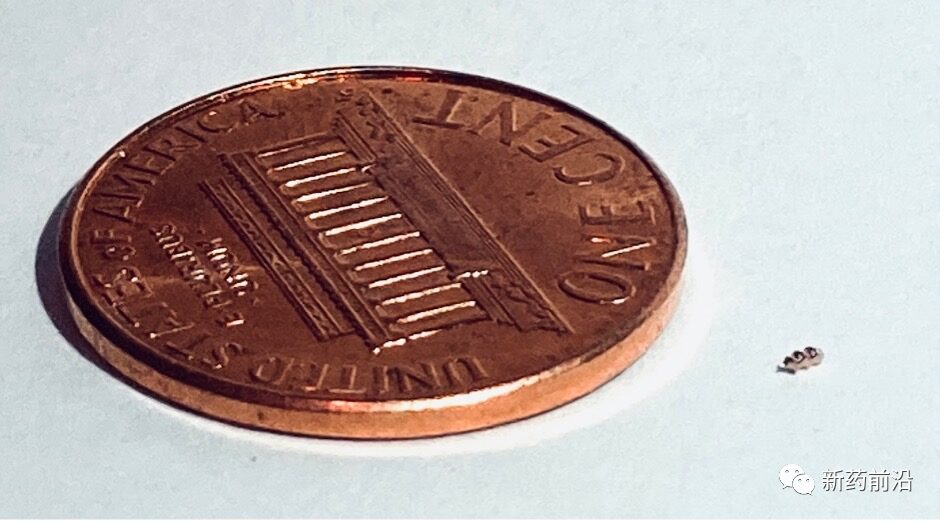Microscopic robots rolling through blood vessels, drilling into the brain, and swimming in the intestines are no longer scenes from science fiction movies. Scientists and engineers are developing microbots, ranging from the size of bacterial cells to the tip of a pencil, that can propel themselves through the body and penetrate deep into tissues. These micro machines function like mini-doctors, delivering drugs and conducting diagnostic tests at precise locations throughout the body.
Microbots are expected to become important tools for treating diseases like cancer, which often occur in tissues that are difficult or impossible to operate on. The most common cancer treatments are chemotherapy and radiation therapy, but they affect the entire body or key areas of the body, not just the tumor, which can also damage healthy tissues.
To target cancer and protect healthy tissues, scientists and engineers have designed various shapes and sizes of anti-cancer microbots, from engineered bacteria and sperm cells to bubble-driven spheres and spacecraft-like robots. Although clinical trials in humans have not yet been conducted, the field of microbot research is expected to achieve exciting results in the translational field in the coming years. The future of cancer treatment may be microscopic.
One of the primary tasks that microbots need to accomplish is determining where to go.
Sylvain Martel, from the Shanghai Jiao Tong University Medical Robotics Institute International Academic Committee, is also the director of the Nano-Robotics Laboratory at the École Polytechnique de Montréal, a Tier 1 Canada Research Chair in Medical Nanorobotics, a fellow of the Canadian Academy of Engineering, and the chair of the IEEE Technical Committee on Micro and Nano Robotics and Automation.

Sylvain MartelProfessor
Martel utilizes naturally magnetic bacteria to design microbots for tumor treatment. His bacteria are particularly well-suited for cancer therapy. The strain Magnetococcus marinus MC-1 has magnetic aerotaxis, meaning they can sense magnetic fields and are guided by them to move towards low-oxygen environments. In the metastatic areas of tumors, proliferating cancer cells create an environment with very low oxygen concentrations, making MC-1 cells ideal candidates for delivering cancer drugs to these regions.
When Martel’s team injected bacterial microbots into human xenograft tumors in mice, under magnetic field guidance, more bacteria penetrated deeper into the tumor after 30 minutes. They also found that the bacterial microbots successfully infiltrated the hypoxic regions of the tumor.
The research group discovered that when they covalently linked anti-cancer drug-loaded nanoliposomes with bacterial micro-motors, the microbots could still reach the hypoxic areas of the tumor.
Martel hopes to advance his microbots into human clinical trials soon. One of the main obstacles to overcome will be scaling up their microbots to work in humans, which are much larger than mice. For example, scaling the magnetic field strength to penetrate thicker human tissues is just one challenge. However, Martel is excited to see the direction of this young microbot field’s development.
With expertise in engineering and micro-nanotechnology, Oliver Schmidt from Chemnitz University of Technology has designed sperm-based microbots that could one day assist in treating ovarian cancer.

Professor Oliver Schmidt
Sperm cells are ideal cells for seeking eggs and can be utilized to build microbots for treating ovarian and cervical cancer. The female reproductive system is their natural environment.
Both ovarian and cervical cancers are difficult to treat because there are often no symptoms in the early stages of the disease, and they typically originate in very narrow structures, such as the fallopian tubes in ovarian cancer. This makes diagnosis and treatment challenging. However, sperm-based microbots can deliver high concentrations of drugs to these narrow, hard-to-reach locations without issue.
Schmidt found that loading sperm cells with anti-cancer drugs was surprisingly easy. When incubated with the anti-cancer drug doxorubicin (DOX), the drug simply transferred to the head of the sperm, where it is not degraded.
From a drug delivery perspective, sperm make this process easier. They naturally penetrate tissues and seem to fuse with cells, leading to drug release. The research group found that human sperm loaded with DOX successfully delivered the drug to patient-derived ovarian cancer spheroids in vitro, reducing the reattachment rate of cancer cells, an indicator of metastatic ability.

Schmidt’s sperm robot head carries the anti-cancer drugDOX, ready to treat tumors
To help the sperm bots locate tumors, Schmidt’s team needed to design a method to guide them. In one iteration of the sperm robot, Schmidt’s team attached sperm cells to a magnetic scaffold, allowing them to be directed in the right direction using a magnetic field. The team also designed a magnetic micro-cap that can guide up to three sperm cells at once, bringing a higher concentration of drugs to the tumor. The micro-cap can also accommodate additional anti-cancer drugs for treatment.
The benefit of using a magnetic scaffold to guide the sperm is that once the sperm robot fuses with cancer cells and delivers the drugs, the researchers can simply guide the magnetic scaffold out of the body.
Using human sperm cells as microbots may encounter some societal or ethical resistance, but when Schmidt’s team discussed using sperm from partners or anonymous donors as sperm robots with cancer patients, the responses were very positive for both options.
Schmidt and his team’s next step is to test their sperm robots in animals and design their robots to selectively target cancer cells.
While cell-based microbots like Martel’s bacteria and Schmidt’s sperm use magnetic fields and their inherent swimming capabilities to propel themselves forward, other types of microbots employ more “dynamic” methods.
For Wei Gao, a nano and micro-robotics engineer at the California Institute of Technology (Caltech), bubbles are the perfect delivery mechanism for microbots targeting colorectal cancer.
Wei Gao’s team propels microbots using microbubbles. By constructing a spherical microbot with a magnesium core and a small opening, when the team exposes their robot to liquids in the small intestine, the magnesium reacts with water to produce hydrogen gas. The hydrogen microbubbles eject from the small opening, propelling the microbot into the intestinal tumor environment.
The team coated the magnesium core with a thin layer of gold to facilitate the magnesium-water reaction and assist in observing the microbots externally. On top of the gold, they layered the anti-cancer drug DOX and covered it with a protective polymer.
Because they have active propulsion, they can penetrate the intestinal mucosal barrier more effectively than passively delivered drugs.
However, the trick with these bubble machines is to get them to the vicinity of intestinal tumors without destroying them in the highly acidic environment of the stomach. To address this issue, Wei Gao and his colleagues designed a protective gelatin microcapsule that the microbots will navigate through the intestine.
Once the microcapsule reaches the tumor through the natural peristaltic waves of the digestive tract, the researchers use near-infrared (NIR) light to open the microcapsule and release the microbots into the tumor.

Wei Gao‘s bubble-driven microbots deliver anti-cancer drugs to intestinal tumors
So far, Wei Gao and his team have demonstrated that their microcapsules can be successfully activated in the intestines of mice, and the released microbots localize to intestinal tumors in mice. The research group has not yet investigated how effective their delivery system is for treating tumors, but they are working on it.
Wei Gao’s team is studying how to scale their system to larger mammals like pigs and eventually humans, and how this will affect their ability to release microbots from the microcapsules using light.
While Wei Gao’s microbots may take years to reach clinical applications, a new, slightly larger microbot has already begun preparations for human clinical trials focusing on brain cancer.
The brain, isolated behind the protective blood-brain barrier, is one of the most challenging organs to treat in the body. When drugs delivered into the bloodstream try to enter the brain, they need assistance to reach their target.
Bionaut Labs, a provider of central nervous system disease treatment in the U.S., is ready to break through this barrier with microbots that deliver life-saving drugs to the brain. Their first target is brainstem glioma, a type of cancer that typically affects children and has a poor prognosis.
The team at Bionaut Labs has named their microbots “bionauts,” like little astronauts carrying cancer drugs exploring the universe of the human body. To get them into the central nervous system, researchers need to inject the robots intrathecally into the spinal cord or brain tissue.
To move the bionauts in the brain, researchers developed an external controller and a helmet-like device containing several electromagnetic coils to generate a magnetic field. Using the controller, the team can maneuver the bionauts throughout the brain to the glioma. Unlike the most skilled human neurosurgeons, the bionaut robots can push brain tissue with precise force, reducing surgical trauma. Once the bionaut reaches the tumor, the team can remotely trigger it to release drugs.

Bionaut Labs‘ brain-penetrating microbots deliver drugs for brain cancer treatment
When researchers tested their procedures in large mammals (over 60 pigs and sheep) using bionaut robots, they found that whether the microbots were rolling in cerebrospinal fluid or gently rotating in brain tissue, there was no damage.
The team is now working to ensure that their bionaut robots meet the electromagnetic safety standards required for human use. They have also ergonomically optimized their surgical system so that when doctors operate with the bionaut, the surgery will be smooth and comfortable.
The researchers aim to begin clinical trials for their bionauts as early as 2023, hoping that the bionauts for treating brainstem gliomas will receive FDA approval by 2025 or 2026.
Michael Shpigelmacher, founder and CEO of Bionaut Labs, stated: “This will have a profound impact on patients’ lives and the ability to treat diseases that are currently completely untreatable, such as brainstem gliomas.”
With the ability to propel themselves through tissues and deliver drugs directly to tumors, microbots may be one of the future directions for cancer treatment. As the field moves excitingly toward clinical applications, these microscopic surgical robots prepared to heal from within are set to shine.
Copyright Notice: This article is from “Frontiers in New Drugs”. Personal sharing and forwarding to friends are welcome. Media or organizations must leave a message on the “Frontiers in New Drugs” WeChat public account for the account name, and after approval, they will be added to the whitelist to obtain reprint authorization. Please indicate the source when reprinting.